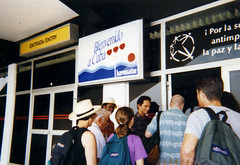by
According to Afro-Cuban activists, racism against blacks in Cuba is systemic and institutional. They say, to this day, blacks are excluded from tourism related jobs, relegated to poor housing, have poor access to health care, are excluded from managerial positions and are more likely to be imprisoned.
Carlos Moore is an Afro-Cuban activist who has spent his life writing about racial injustice in Cuba and says race is the country’s most pressing issue. In 2008, he sent a scathing letter to Cuban leader Raul Castro demanding racial reform. In it, he states: “You are a descendant of Europeans born in Spain; I am a descendant of Africans born in the Caribbean. We are both Cubans. However, being Cuban confers no specific privilege on either of us as human beings”.
It was a luxury of civil protest he could only afford to write while exiled in Brazil. According to Moore, “There is an unstated threat. Blacks in Cuba know that whenever you raise race in Cuba, you go to jail. Therefore, the struggle in Cuba is different. There cannot be a civil rights movement. You will have instantly 10,000 black people dead”. He says a new generation of Cubans are looking at politics in another way.
That new generation is going the way of the world wide web. Henry Gomez, a White Cuban living in Florida, noticed that some of the most outspoken voices against racism in Cuba are bloggers. So he founded Bloggers United for Cuban Liberty (BUCL).
“We basically organize events, distribute press releases and try to obtain coverage to counter the official propaganda coming from the Cuban Government” states Gomez, a writer for Babalu, a website that he says is the most widely read English language blog about Cuba.
Cuba was a former Spanish colony and the destination of hundreds of African slaves. According to Gomez, the Cuban Revolution of 1959 did little to liberate blacks. Since then, he says, former Dictator Fidel Castro has been successful in portraying Cuba as a post-racial egalitarian utopia. For example, Gomez says “Cuba began to develop the tourist sector of the economy in the mid-90’s and blacks were kept out of many positions that interfaced directly with foreign visitors. Also, blacks are extremely underrepresented in the higher echelons of the Cuban government bureaucracy.”
Countless blogs by Cuban writers seek to disprove so-called propaganda authored by the Cuban government. The U.S. State Department estimates Afro-Cubans make up 62 percent of the Cuban population. However, the Cuban census registers that 65 percent of the population is White.
Gomez says the Cuban government pays lip service to the issue of race. “It’s frankly the government that is the biggest perpetrator of racism in Cuba. As for Afro-Cuban opposition leaders, many of them are in jail such as Dr. Darsi Ferrer and Dr. Oscar Elias Biscet. Both are Afro-Cuban medical doctors who are rotting in Cuban prisons for their political beliefs.” Recently, an Afro-Cuban political prisoner, Orlando Zapata Tamayo, died in prison after a lengthy hunger strike. “Remember, this is a totalitarian dictatorship that has essentially remained unchanged for 51 years,” added Gomez.
Last November, sixty African-American scholars and professionals condemned the Cuban regime’s apparent crackdown on the country’s budding civil-rights movement. They issued a statement called “Acting on Our Conscience” which also called for the immediate release of imprisoned Afro-Cuban civil rights leaders. Traditionally, many African-Americans leaders sided with the Castro regime and condemned the United States, which in the past, sought to topple the Cuban government. The public rebuke of Castro’s racial policies signed by prominent African-Americans like Cornell West, Ruby Dee and Mario Van Peebles just to name a few, may indicate a changing of the tide. However, pro-government Cubans rejected allegations of racism and repression on the island, calling the charges “delusional” and part of “an anti-Cuban campaign.” They went on to point out that Cuba outlawed discrimination in 1959 and promotes Afro-Cuban culture through museums, music, dance and other institutions.
But the lack of acknowledgment by Cuba’s government does little to contain the movement of racial equality that is gaining momentum among Cuban human rights activists who are using their computers as their main weapon in the fight against racism. With each blog entry or letter, they expose what they call one the most blatantly racist places in the world.
But at the same time they remain hopeful that some of the racial progress seen in America can take root in Cuba as well. “I have no doubt that when Cuba joins the world democracies that it will have many Afro-Cuban leaders and presidents,” says Gomez, who is leading the new voice of Cuban Activists online. While Moore, who has spent the last forty years in exile and published dozens of books and articles about race relations in Cuba believes it threatens the Castro regime, as more blacks in the country feel empowered by an Obama presidency in America. He says, “Something is happening in Cuba, making them more paranoid than usual on the race subject.”















